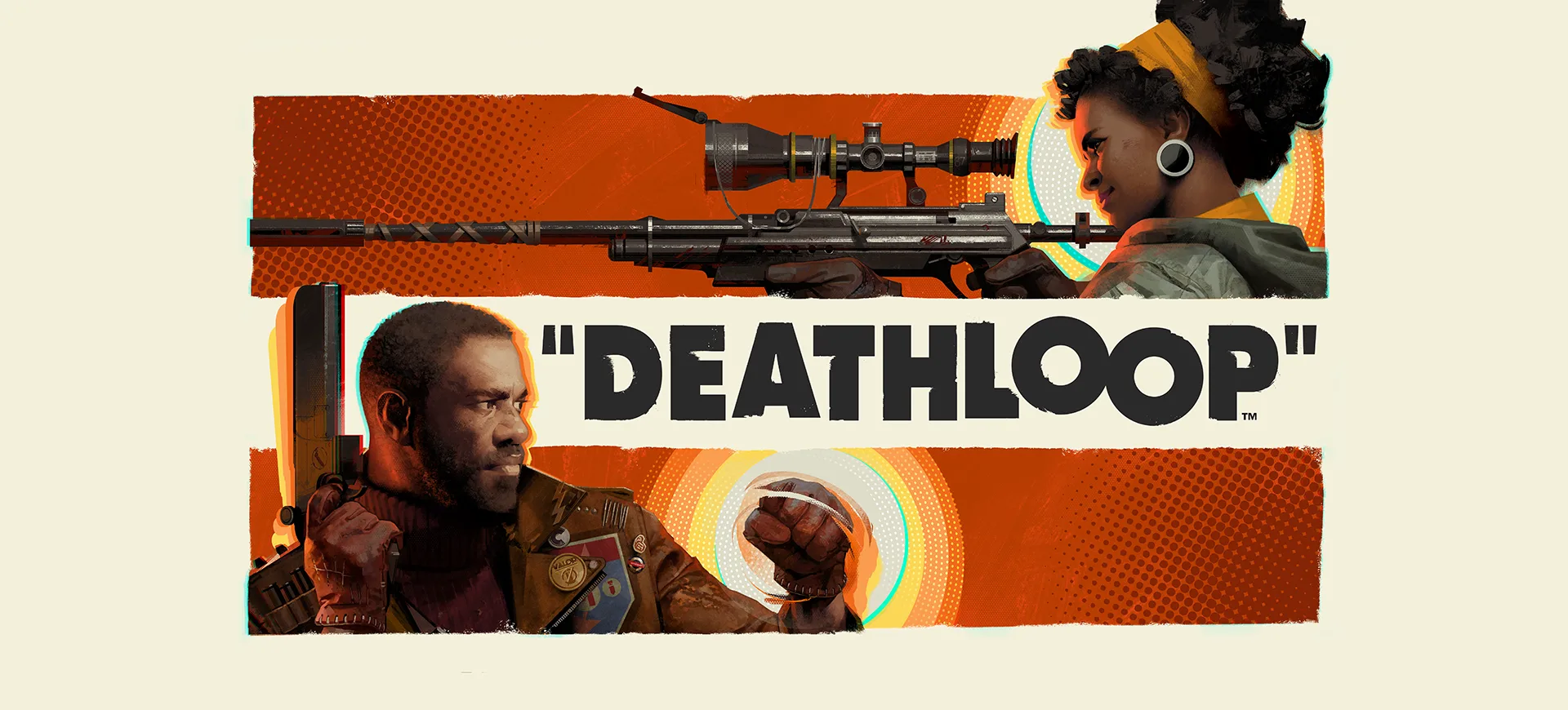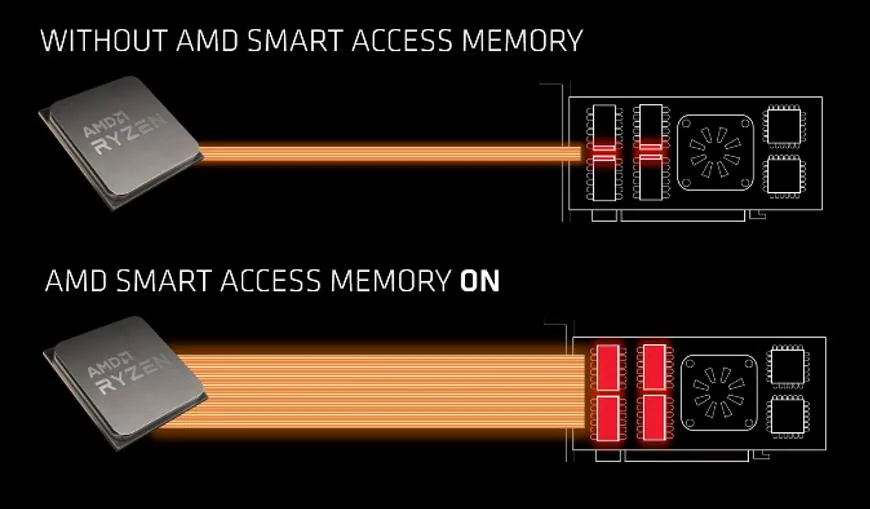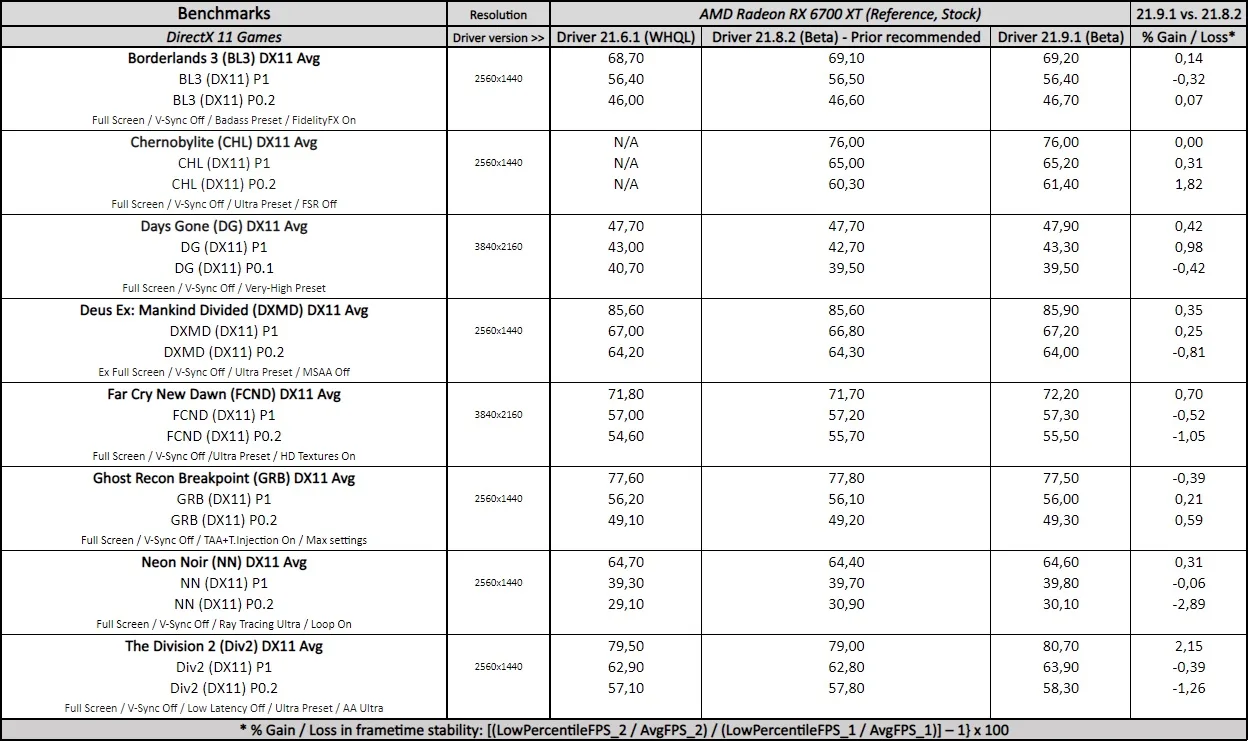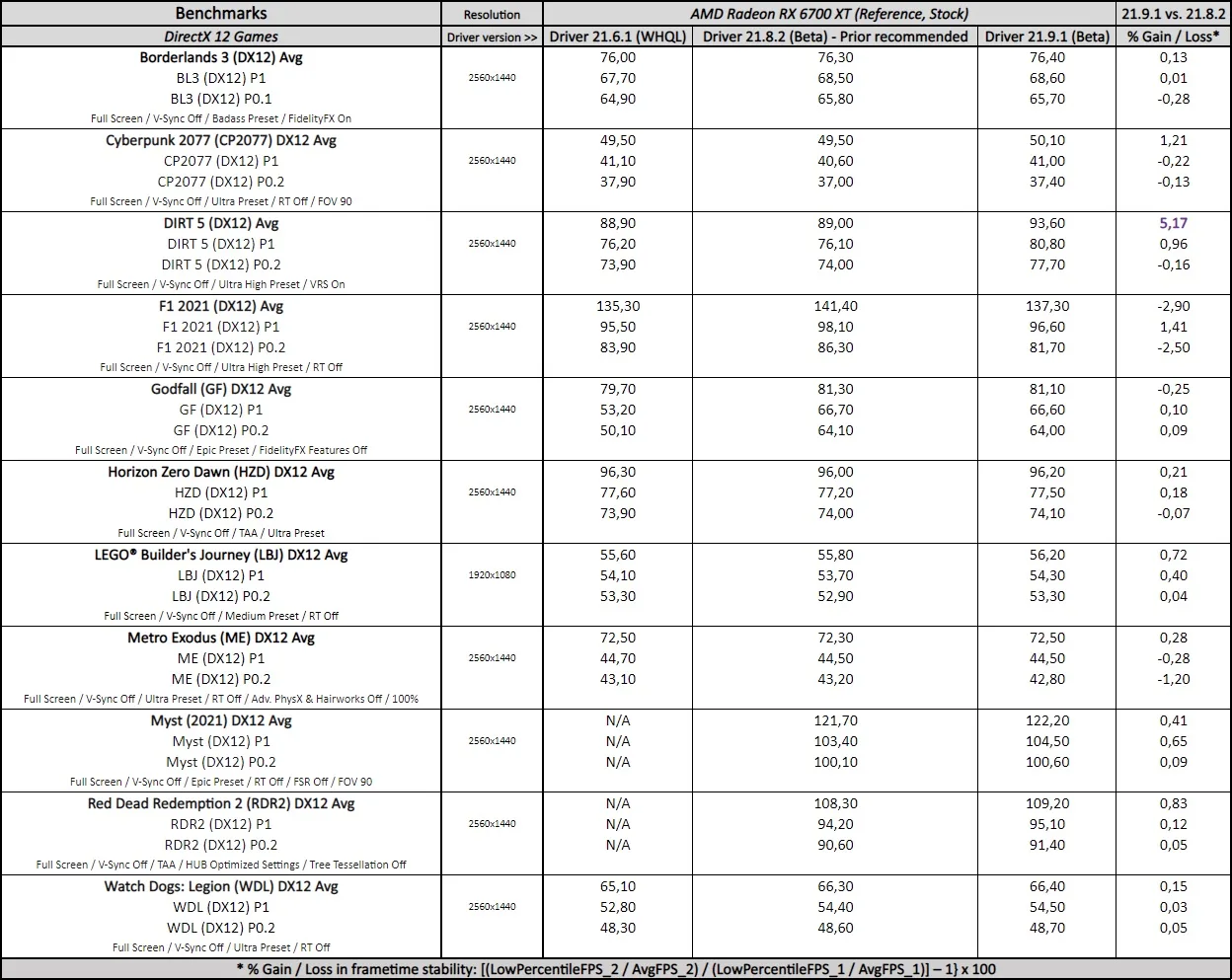Adrenalin 21.9.1 Driver Performance Analysis – 24 games benchmarked using the RX 6700 XT
This review showcases Radeon Adrenalin driver performance of the reference AMD Radeon RX 6700 XT (RDNA 2.0) with 24 PC games. We use the latest AMD Optional (beta) Adrenalin 21.9.1 driver released a few days ago and compare these drivers versus our previously recommended driver 21.8.2. We also chart the performance of the 21.6.1 (WHQL) drivers as a reference, and we perform all tests on the same game version and with the same OS build.
For our Adrenalin driver reviews, we use ‘beta’ instead of ‘Optional’ and ‘WHQL’ instead of ‘Recommended’. We don’t use AMD’s Recommended label since we recommend drivers.

Our testing platform is a recent install of Windows 10 64-bit Pro Edition, an i9-9900K with stock clocks, a Gigabyte Z390 AORUS PRO motherboard, and 32GB of T-FORCE XTREEM ARGB WHITE DDR4 3200MHz. The games tested, settings and hardware, are identical except for the drivers we compare.
Benching Methodology
Test Configuration – Hardware
- Intel Core i9-9900K (Hyper-Threading/Turbo boost on; stock settings)
- Gigabyte Z390 AORUS PRO motherboard (Intel Z390 chipset, v.F12l BIOS)
- T-FORCE XTREEM ARGB WHITE 32GB DDR4 (2×16GB, dual-channel at 3200 MHz CL14), supplied by TeamGroup
- AMD Radeon RX 6700 XT (Reference) 12GB, stock clocks, on loan from AMD
- Samsung 500GB SSD 960 EVO NVMe M.2
- WD Blue 1TB SATA SSD
- Corsair RM750x, 750W 80PLUS Gold power supply unit
- ASUS TUF Gaming VG289Q 28? IPS UltraHD (3840×2160) 60Hz 5ms FreeSync Monitor (Fixed Refresh Rate On) when testing games at 2160p resolution.
- ASUS ROG Swift PG279Q 27? IPS QuadHD (2560 x 1440) 165Hz 4ms G-Sync Monitor (Fixed Refresh Rate On) when testing games at 1440p or 1080p resolution.
Test Configuration – Software
- Radeon Software Adrenalin 21.9.1 beta drivers, 21.8.2 beta drivers, and 21.6.1 WHQL drivers; Radeon features ‘Disabled’, texture filtering quality set to ‘High’, and tesselation mode set to ‘Use application settings’; AMD FreeSync ‘Disabled’ (when applicable).
- Resizable BAR off – Why? Read main reasons here.
- V-Sync ‘off, unless application specifies’ in the Software Adrenalin control center; V-Sync off in-game.
- AA and AF as noted in games; all in-game settings are specified.
- Windows 10 64-bit Pro edition, latest updates v21H1, High-performance power plan, HAGS off, Game Mode, Game DVR & Game Bar features off.
- GIGABYTE and ASUS tools not installed.
- Latest DirectX
- All 24 games are patched to their latest versions at the time of publication.
- 3DMark’s suite and UNIGINE Superposition benchmark, the latest version
- Basemark GPU benchmark, v.1.1
- UNIGINE Superposition, v.1.1
- CapFrameX (CX), the latest version
- RivaTuner Statistics Server (RTSS), the latest version
- Display Driver Uninstaller (DDU), the latest version; always uninstall old driver using DDU in safe mode, clean, and restart.
-
ISLC (Purge Standby List) before each benchmark.
Radeon Software Adrenalin Suite-related
- The minimal Radeon Adrenalin Software installation is used.
- We install the display driver.
- We enable the ‘Issue detection’ setting.
Hybrid & Non-Synthetic Tests-related
- Single run per test.
Game Benchmarks-related
- We use the corresponding built-in or custom benchmark sequence.
Frametimes Capture & Analysis tool-related
- CapFrameX is used for capturing and analyzing the relevant performance numbers obtained from each recorded built-in or custom benchmark sequence.
- Consecutive runs until detecting 3 valid runs (no outliers) that can be aggregated by CapFrameX using the following method:
- ‘Aggregate excluding outliers’:
- Outlier metric: Third, P0.2 (0.2% FPS percentile).
- Outlier percentage: 3% (the % the FPS of an entry can differ from the median of all entries before counting as an outlier).
- ‘Aggregate excluding outliers’:
- We compare and value the results and aggregated records in terms of percentages of gain/loss, by setting the following thresholds to consider a certain % value as significant (not within the margin of error) for our benchmarking purposes:
- Score/FPS Avg > 3% when valuing hybrid and non-synthetic benchmarks;
- FPS Avg > 3% when evaluating raw performance;
- P1/P0.2 > 3% when evaluating frame time consistency; after applying our custom formula
{[(LowPercentileFPS_2 / AvgFPS_2) / (LowPercentileFPS_1 / AvgFPS_1)] – 1} x 100
Benchmark Suite: 24 PC Games, 4 Hybrid & 4 Non-Synthetic Tests
Hybrid Tests (3DMark)
- DirectX Raytracing feature test
- Fire Strike Ultra
- Port Royal
- Time Spy Extreme
Non-Synthetic Tests
- Basemark GPU
- Boundary: Raytracing Benchmark
- Neon Noir (Benchmark)
- UNIGINE Superposition
DX11 Games
- Borderlands 3 (DX11)
- Chernobylite (DX11)
- Days Gone (DX11)
- Deus Ex: Mankind Divided (DX11)
- Far Cry New Dawn (DX11)
- Neon Noir (DX11; Loop Mode)
- Tom Clancy’s Ghost Ghost Recon Breakpoint (DX11)
- Tom Clancy’s The Division 2 (DX11)
DX12 Games
- Borderlands 3 (DX12)
- Cyberpunk 2077 (DX12)
- DIRT 5 (DX12)
- F1 2021 (DX12)
- Godfall (DX12)
- Horizon Zero Dawn (DX12)
- LEGO® Builder’s Journey (DX12)
- Metro Exodus (DX12)
- Metro Exodus PC Enhanced Edition (DX12)
- Myst (2021, DX12)
- Red Dead Redemption 2 (DX12) – NEW
- Shadow of the Tomb Raider (DX12)
- Watch Dogs: Legion (DX12)
Vulkan Games
- DOOM Eternal (VK)
- Quake 2 RTX (VK; v.1.5.0)
- Red Dead Redemption 2 (VK) – NEW
- Strange Brigade (VK)
- Tom Clancy’s Ghost Recon Breakpoint (VK)
- Wolfenstein Youngblood (VK)
Software Adrenalin Control Center Settings
Here are the global Adrenalin Control Center settings:

All AMD Radeon Software Adrenalin settings are set so that all optimizations are off, Texture filtering is set to ‘High’, and Tessellation uses application settings. These settings are used across all drivers so that the performance of each driver version can be compared accurately.
AMD Radeon Software Adrenalin 21.9.1
This latest Radeon Software Adrenalin 21.9.1 beta driver was released on Monday (09/13/21) primarily for the launch of Deathloop and Call of Duty Vanguard Open Beta.

This new driver also brings support for AMD Smart Access Memory on Radeon RX 5000 Series Graphics, Microsoft Windows Insider Program for Windows 11, and four more Vulkan API extensions.

The download links for the Adrenalin 21.9.1 beta drivers can be found starting here. The 21.8.2 release notes can be found here.
Here are the release highlights of Adrenalin v21.9.1 from AMD Radeon’s website:
Support For
-
-
-
- Deathloop
- Call of Duty Vanguard Open Beta
- AMD Smart Access Memory on Radeon RX 5000 Series Graphics
- Microsoft Windows Insider Program for Windows 11
-
-
Added Vulkan Support
-
-
-
- VK_KHR_zero_initialize_workgroup_memory
- VK_KHR_shader_integer_dot_product
- VK_EXT_shader_atomic_float2
- VK_EXT_load_store_op_none
-
-
Fixed Issues
-
-
-
- Visual artifacts in PAYDAY 2 may be observed during gameplay on some AMD Graphics products such as Radeon RX 6800 XT.
- Connecting two displays with large differences in resolution/refresh rates may cause flickering on Radeon RX Vega series graphics products.
- On Radeon RX 5500 XT Graphics, higher than expected memory clock speed and power consumption may be experienced when idle and the display’s resolution and refresh rate are set to specific values such as 1080p @ 60Hz.
- While playing Assassin’s Creed Odyssey, driver timeouts or black screens may be experienced on some AMD Graphics products such as Radeon RX 480 Graphics when the user quickly navigates through the game menus or swiftly looks around an environment with their character.
-
-
The Adrenalin 21.9.1 Driver Performance – Summary Charts with 24 Games
Below you can find the summary charts of our representative selection of 24 games plus 4 hybrid and 4 non-synthetic benchmarks. We chart our games’ driver performance progression from version 21.8.2 to 21.9.1 using the reference AMD Radeon RX 6700 XT.
You can see the list of graphics settings on the charts, and we run each built-in or custom game benchmark’s sequence at 2560×1440, except for Days Gone and Far Cry New Dawn, tested at 3840×2160 resolution; and LEGO® Builder’s Journey (DX12 & DXR) and Watch Dogs: Legion (DXR) which are tested at 1920×1080 resolution. You may click on each chart to open a pop-up for the best viewing.
Results give average framerates and higher is better. We display the low FPS percentiles (P1 and P0.2) below the corresponding averages. We use CapFrameX to record frametimes over time and to visualize and convert them into their corresponding average FPS and P1 and P0.2 FPS percentiles values.
There are also columns showing percentages of gain/loss in both raw performance (average FPS) and, when applicable, in frametimes consistency or stability between the different driver versions. We applied the following custom formula to calculate the stability gains or losses:
{[(LowPercentileFPS_2 / AvgFPS_2) / (LowPercentileFPS_1 / AvgFPS_1)] – 1} x 100
We mark significant performance changes (higher than 3%) in bold and use purple for the significant improvements or orange font for regressions.
Adrenalin 21.9.1 Driver Performance Charts







Notes on Adrenalin 21.9.1 Driver Performance – 21.9.1 (beta) vs. 21.8.2 (beta)
From the charts, although most hybrid and non-synthetic tests show no significant differences between drivers using our RX 6700 XT, we see a noteworthy improvement in the DirectX Raytracing feature test and a regression in the Basemark GPU (Vulkan) test.
For the game benchmarks, although most games show no significant differences when we move to the 21.9.1 beta drivers from the 21.8.2 beta driver version, we found significant performance improvements in DIRT 5 (DX12 and DXR API modes) and in Myst (2021, DXR API mode) in terms of raw performance.
Disclaimer
Please be aware that the following results, notes, and the corresponding driver recommendation are valid for similar RDNA 2.0 gaming rigs on Windows 10 v21H1. Its representativeness, applicability, and usefulness on different AMD Radeon micro-architectures, testing benches, and Microsoft Windows versions may vary.
Conclusion
Based on our previous results and findings, we recommend RDNA 2.0 gamers update to the latest Adrenalin 21.9.1 beta driver. Its raw performance and smoothness or frametimes consistency level are overall on par with our previously recommended driver 21.8.2 using our RX 6700 XT GPU.
There are relevant qualitative reasons that also make it advisable to upgrade to version 21.9.1. These reasons include the higher level of driver bug fixes, the optimizations for the latest games, and support for the latest AMD Radeon technologies.
Let’s Play!
***
Rodrigo González (aka ‘RodroG’) is an enthusiast gamer and tech reviewer especially interested in shooter games, open-world role-playing games, and software and hardware benchmarking. He is the author of the NVIDIA WHQL Driver Performance Benchmarks Series and founder and moderator of the r/allbenchmarks community on Reddit.
*The featured image is from AMD.